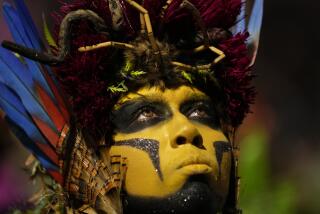Homicidal Streak in S. American Tribe Studied by Anthropologist
- Share via
For centuries, thousands of Yanomamo Indians have lived in seeming idyllic innocence in the vast tropical rain forests along the Brazil-Venezuela border, far removed from advanced civilization. But their carefully tended gardens of plantain, bananas, sugar cane and tobacco belie an astonishingly violent streak, says a new research paper.
When the 15,000 Yanomamo are not hunting animals and collecting wild honey, they are often killing each other, says UC Santa Barbara anthropologist Napoleon A. Chagnon, who has been visiting them for nearly a quarter of a century. In fact, the Yanomamo are one of the most violent cultures known, he said. In a paper published today in Science magazine, Chagnon reports that almost half of the Yanomamo have killed someone, and two-thirds of the adults have lost a close relative to homicide.
The paper is “probably the most detailed account that has ever appeared in anthropology of mortality among males as it relates to warfare,” said anthropologist Robert Carneiro of the Museum of Natural History in New York City.
Chagnon’s findings reinforce an emerging consensus among anthropologists that violence is continually present in primitive societies. “I’m not saying that man has genes for warfare or violence,” Chagnon said, “but that the strong will take advantage of the weak whenever it benefits them.”
That principle is as applicable in arms control negotiations as it is in primitive tribes, he added.
Chagnon acquired extensive genealogical data for 12 villages that have had minimal contact with outsiders.
“The thing that distinguishes his work . . . is that he doesn’t rely on impressions,” said anthropologist Raymond Hames of the University of Nebraska. “He very carefully and exhaustively collects hard data to get an accurate picture of what is going on.”
From the genealogical data, Chagnon concluded that 44% of the males over the age of 25 in the villages had participated in killing someone, that 30% of all male deaths were due to violence and that nearly 70% of all adults over age 40 had lost at least one close relative--parent, spouse, sibling or child--to violence.
Chagnon said that most of the fights involve revenge in sexual matters: infidelity, an attempted seduction of a man’s wife, abduction of women by visiting groups or failure to give a promised daughter in marriage.
Not Many Women
Women are a scarce commodity among the Yanomamo. Some villages have as many as 30% more men than women. Even so, because of the need for male warriors to protect the village, female infanticide is common among the Yanomamo, said sociologist John F. Peters of Wilfrid Laurier University in Waterloo, Canada, who has spent eight years among them.
Although revenge may seem counterproductive, Chagnon said, “groups that retaliate swiftly . . . acquire reputations for ferocity that deter the violent designs of their neighbors.”
Chagnon also found that evolutionary forces perpetuate this behavior. He found that men who had killed had, on average, nearly three times as many wives and 2.5 times as many children as those who had not killed. The most aggressive men were thus the most likely to reproduce.
Those who do not exact revenge risk losing their women, Chagnon found. He cited one village of 75 people whose leader was killed. The killing so demoralized the group that, for about a year, its members sought refuge and protection among neighboring groups. The protectors soon began to seduce and steal the visitors’ women, Chagnon said.
Only when the men of the first village began “an ambitious schedule of revenge raids” were they able to retain their dignity and independence, as well as their women, Chagnon said. “They had to maintain a balance of power,” he added.
Shotguns Brought In
A drastic change in the balance of power occurred in the early 1970s when outsiders introduced some Yanomamo to shotguns. Those who possessed the weapons quickly dominated the area, and men from other villages went to extraordinary lengths to obtain weapons for themselves--even leaving their tribal areas to work as menial laborers.
A dramatic escalation in violence ended only when missionaries and other outsiders cut off the flow of ammunition and restored the balance of power.
Chagnon and Peters note that the culture they studied is rapidly disappearing. Within the past decade, violence has been dampened considerably by the influence of Catholic and Protestant missionaries and by sharp changes in the Yanomamo life style.
Many villages have begun farming for profit to acquire steel tools and the amenities of civilization. Children are being educated by the missionaries, and many travel long distances to cities for advanced training.
Outsiders are also encroaching on Yanomamo reservations to mine newly discovered gold and tin deposits, and many experts fear that the tribesmen will be pushed off their native lands. “They may even disappear as a distinct entity,” said Peters.
More to Read
Sign up for Essential California
The most important California stories and recommendations in your inbox every morning.
You may occasionally receive promotional content from the Los Angeles Times.













